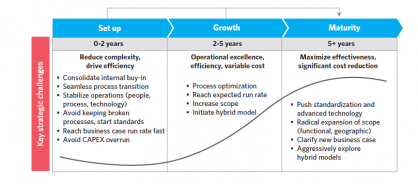- Point of view
How to leapfrog the global business service maturity curve
The secret: reconcile four contradictory challenges

With access to technology and expertise, today's global business services (GBS) organizations have a distinct advantage. Used correctly, they can leapfrog the traditional GBS maturity curve and move beyond cost savings. That's how they can meet their businesses' evolving needs for greater agility, risk management, and growth. But first, they must address four concepts that seem contradictory, but needn't be.
Things aren't as they first appear when it comes to assessing the progress of global business services. True, most GBS organizations have met their initial business-case objectives in terms of compliance, cost savings, and—in the case of offshoring—labor arbitrage. But they often fail to scale up or penetrate deeper into processes that add greater value. Most global corporations know an effective GBS organization gives them a competitive advantage. Yet CXOs aren't convinced they promote innovation.
As figure 1 shows, companies want global business services to make them more agile and adaptable, to help them manage risk and compliance, and to increase growth and scalability. They also want to reduce capital and asset intensity, as well as costs, while enabling innovation.
Figure 1: Most GBS organizations are meeting customers’ basic business requirements, but these needs are changing

The question is:
How can GBS leaders address this reality and meet their businesses' basic and evolving needs? The answer: By mastering seemingly competing demands in four areas. To do this they must:
- Standardize and stay flexible
- Commit to efficiency and innovation
- Run centers of work and centers of excellence (CoE)
- Focus on robust service and collaboration
GBS organizations typically follow a linear progression through the maturity curve shown in figure 2. But with nimble digital technologies—and design thinking methods that focus on the end user—enterprises have the opportunity to leapfrog across stages rather than move from one to the next. This is even more likely if they embrace approaches that foster process excellence and can adapt to a volatile environment.
Companies must rethink their processes beyond the front end, and into the middle and back office. The GBS organization plays a pivotal role in this transformation.
Figure 2: The GBS maturity curve

Flexibility and standardization?
For many shared-services leaders, it's hard to accept variation, let alone actively accommodate it. After all, the main rationale for adopting global business services is to create savings by making shared processes reliably repeatable at scale. But in the last decade, people have come to expect a flexible, on demand response to their specific needs.
Enterprises can't leapfrog the maturity curve without learning how to make flexibility standard. The good news is that with cloud-based technologies no one needs to wait for a common ERP or single master data. With the analytics tools now available, firms can achieve standardization at the back end and still offer user flexibility at the front end.
Let's take the analogy of the Bloomberg app used by investment professionals managing portfolios. The data in this app flows from standard sources, such as stock markets, commodities and futures markets. Yet what users see is the highly-customized, analytics-driven output from their search based on the filters they choose. So a day trader sees the daily movement of stock prices while the long-term trader gets a broader perspective.
As a result, users feel empowered to make more informed business decisions. Here's the kicker, however. At the back end, everything is standardized; Bloomberg doesn't customize its technology for individual users.
We can apply the same logic to GBS operations, where enterprise performance management relies on a common back end. When managing financial performance and analysis, companies often have thousands of customized reports. But today, there's a fundamental shift away from report production towards technology that filters data to quickly deliver self-service insights specific to the user's situation.
Structuring for innovation and efficiency?
Just as companies can standardize and be flexible , they can also invest in innovation while increasing efficiency. But if they focus on squeezing 10%-15% more out of existing processes, they might miss the chance to radically redesign operations to impact performance by 50%-80%.
Consider collections, a key yet often poorly performing part of a broader order-to-cash process. Firms tend to concentrate on making their existing operations more efficient. Yet that may not move the metrics needle on working capital or receivables. By contrast, the latest technology and analytics can provide greater visibility into what's happening upstream. They can allow CFOs and sales leaders to see what's causing payment disputes and receivables issues, and indicate how to fix them. Armed with these actionable insights, they can segment customers and structure changes to engage with them in the contracting cycle.
With a focus on both innovation and efficiency, companies can radically improve their receivables profile, cash flow, and working capital, while also reducing costs.
Centers of work and excellence?
Here, it's key to recognize that competence and expertise, which flourish in concentrated ecosytems, are often more important sources of value than efficiency. Historically, shared services sought to aggregate work from across the business, increase standardization, and take advantage of economies of scale. But they ran in functional silos. That prevented organizations from managing processes end to end and reduced their ability to generate real business impact beyond cost reduction. Yet it needn't be an either-or situation. Centers of work and centers of excellence can run alongside each other.
Centers of excellence focus on advancing a business objective, not just running a process. For example, consider a center of excellence for internal controls at a globally distributed company. Its business objective is to manage the architecture in all its facilities for control testing, monitoring, and evaluation. The latest technology helps here. It can perform remote transaction monitoring around the world and apply advanced analytics in real time to readjust risk profiles when called for. If necessary, stakeholders can carry out follow-on research or discussions locally, while the center of excellence maintains consistency in the controls operating model, standards, and analytics.
Another example is business reporting. Organizations are shifting away from analyzing past performances toward more predictive modelling and scenario management. To benefit from a CoE architecture, they need people with different skill sets, such as data scientists and modelling experts. That means analysts can now use reports to act as true business partners and leave massaging data to the experts in the CoE.
Focus on service and collaboration?
Shared services operations have traditionally had an arm's-length relationship with their internal customers.
They haven't always been accountable to committed outcomes, such as cost or cycle-time reduction. Meeting agreed targets alone, however, doesn't guarantee customer satisfaction or take the whole process to the next level. For that to happen, companies must engage and collaborate with customers to solve business problems and meet service level agreements (SLAs).
Digital advancements, such as visualization technology, can really help with collaboration. They overcome distances with virtual, face-to-face meetings, and encourage far better conversations than static PowerPoint dashboards or reports.
Negate the need for trade-offs with a different approach
To take their GBS organizations to the next level, companies do well when they embrace the four contradictions and rid themselves of preconceived notions. And by taking an approach that combines technology and human expertise, global business services can leapfrog the maturity curve to deliver impact beyond the original business case. Firms that are ready to make the leap will address their company's rapidly evolving needs.